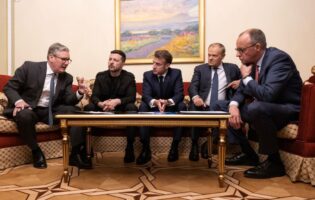1989-2009: Germany and Transatlantic Relations
On Wednesday, November 4, 2009, the American-German Institute (AGI) hosted a conference on “1989-2009: Germany and Transatlantic Relations 20 Years after the Berlin Wall.” The conference is part of AGI’s larger project on “60 Years Federal Republic of Germany: Rebuilt, Reunified, Revitalized?” and was generously funded by the Transatlantik-Programm der Bundesregierung der Bundesrepublik Deutschland aus Mitteln des European Recovery Program (ERP) des Bundesministeriums für Wirtschaft und Technologie (BMWi). The conference was also funded by the Draeger Foundation and by the AGI Foreign & Domestic Policy, Business & Economics, and Society, Culture & Politics programs.
The first panel discussed the relationship between eastern and western Germany twenty years after the fall of the Berlin Wall and how the experience of a divided Germany has shaped today’s decision-makers. Looking at the political and economic realities, the speakers concluded that differences do still exist between the “old” Bundesländer and the “new” Bundesländer twenty years later. In elections, there is a difference between the overall winner and the winner in the east, a result of a different political reality in the east shaped by three factors: First, there is a misunderstanding of the development of events in 1989 and the idea of a peaceful revolution. Indeed, Saxony is the only Land where one could discuss a peaceful revolution in the autumn of 1989 and is today the only eastern state with the same governing coalition as on the federal level. Second, leaders underestimated the impact of forty years of dictatorship on people in the east. Third, a political schism still exists between the two parts of the country, evidenced by the rise of leftist parties in the east. Furthermore, when looking at Die Linke and the Social Democratic Party (SPD), one sees that Die Linke has a higher voter turnout and better organization. Still, there is hope that a younger generation of policymakers will bring about a convergence between western and eastern Germany. This can be seen, to a certain extent, in Brandenburg, where there are now five parties in the parliament, including the Free Democratic Party (FDP) and the Greens. Throughout eastern Germany, however, there is a danger of focusing on fond personal memories from the time before the Wall fell and forgetting the poor living conditions and infractions on freedoms inherent in the GDR.
Throughout eastern Germany, people struggle to come to terms with the forty year history of being ruled by the Socialist Unity Party (SED). Without their own experiences, young people need to learn GDR history in schools and through memorials – much as western Germans did after the Second World War, although the GDR’s crimes are not comparable in scope to those of the Third Reich. Additionally, foreign pressure to acknowledge and come to terms with the past is missing. One legacy of the GDR that impacts eastern Germany’s current development is the poor economy, which includes the need for modernization and the lack of opportunities for young people, evidenced by the numbers of young people who leave eastern Germany in search of better opportunities in the west or abroad. For eastern Germany to flourish, it will be crucial for it to provide new opportunities, such as in the scientific clusters found in Dresden and Jena, and new perspectives in order to retain its young, skilled workers.
At the time of reunification, the view of “flowering landscapes” in the east was widely held; twenty years later, the rhetoric has taken on a more negative tone – interesting, considering that labor productivity has doubled, income increased, health improved, and living standards are now comparable with the west. At the time of economic reunification, some questioned whether the events in 1990 could lead to the same results in the 1950s – namely, a Wirtschaftswunder. However, the political and economic conditions in 1990 were more radical than in the late 1940s, devoid of an existing economic relationship between east and west and lacking Keynesianism, and in which exports from the east struggled to compete with stronger, pre-existing western companies. Expectations of full convergence with the “old” Länder were predominant in the early 1990s, when the eastern states quickly reached about 70 to 80 percent of the western states but then stagnated later in the decade as they struggled to catch up.
Still, twenty years after the fall of the Berlin Wall, there is significant entrepreneurship in the eastern states, evidenced by the growing number of small firms. Likewise, the manufacturing sector is growing and the eastern states with their new industries (e.g., solar energy) are likely to be less impacted by the economic downturn in 2008-2009 than the western states with their usual consumer products. There is a general migratory trend from rural areas to the economic clusters in the new states – but also from the new states to the old states.
The question remains whether policy made such a difference in the transition economy of eastern Germany in 1990, or if it was the fundamentals of movement of people and increased income. In general, eastern Germany’s economic transition was well implemented, even if other regulatory experiments could have proven helpful. Indeed, no other central and eastern European transition economy has had the same increase in living standards; nor do they have Germany’s same unemployment problem.
The fall of the Berlin Wall and subsequent end of the Cold War had repercussions not just in Germany, but throughout Europe, must visibly with the rounds of enlargement of the European Union that extended to former members of the Warsaw Pact. The second panel addressed these repercussions from a broader European perspective and an American perspective. That the outcome of 1989 in Europe was peaceful was not a foregone conclusion; the civil wars throughout the Balkans serve as a reminder that the end of the Cold War could have turned out quite differently.
1989 was both a victory for the West and a game-changer. Much of the enthusiasm at the time did not consider the challenges ahead. For France and Germany, the EU was the only option to make the best out of the fall of the Wall and German unification; globally, it was perceived as both necessary and ambitious.
Immediately following 1989, Europeans responded by adopting the Maastricht Treaty as a starting point for greater EU integration. As the EU grew, it was able to use its leverage to encourage hopeful eastern member states to undergo reforms in a democratic, political process. Germany led – and continues to lead – the EU in integrating many of its neighbors into the EU’s structures, although Germany’s concern for consensus and conflict avoidance may well impinge on its ability to lead in the EU. Indeed, the give-and-take of conflict and negotiation will characterize the way forward in EU integration, especially as countries try to think “outside the box” about Europe – that is, how best to identify what Europe is as a political actor, both within the EU and in the international arena. Thus, the U.S. will need to be patient with Europe as it continues to grapple with its own growing pains, but should also know that Europe is headed in the right direction.
As the EU grows – Croatia will likely join in 2012 – it will also need to reaffirm its commitment to states outside the somewhat nebulous borders of Europe, namely, Ukraine and Turkey. To do so, the EU will need to change its visa policy. In the years ahead, it will also need to integrate its energy markets and further develop the Eastern Partnership – all of which would greatly benefit from German leadership.
Today, European unity is incomplete, but the Union is a fact – even though many opinion polls show that citizens think EU enlargement increases their own domestic difficulties. Different narratives abound across Europe about the end of the Cold War, with continued disagreement. Within the Union, the end of the Cold War is seen more positively than in other countries: new EU members are more positive about the collapse of communism than are other post-Soviet states.
Going forward, the EU will need to make its constellation of different national choices more consistent throughout the Union and it needs to prove its relevance in finding global solutions. As demonstrated during the transatlantic rift during the Bush administration, shared values do not necessarily yield cohesive foreign policy – and the same is true within Europe.
While France and Germany supported the policies of deepening and widening the European Union after 1989, Great Britain had concerns, many of which are still relevant today. By resolving the “German question,” Great Britain lost some of its influence as a world power and there has been a noticeable decline in Britain’s importance over the past twenty years. Rather than embracing the European Union, Britain has emphasized bilateral relations, above all, with the United States. While the Bush/Blair relationship was especially strong, in recent years Germany has overtaken Great Britain as a friend to the U.S.; one example of this strong relationship is Germany’s position during the financial crisis, which it seems to have weathered much better than the British. Britain is a continually skeptical partner in the EU, withdrawing from some important EU agreements (among them the Schengen visa policy and monetary union); consequently, Germany is increasing its leadership role in the EU. Within the EU, with the U.S., and increasingly with Russia, Germany is a leader on the European continent, to both the envy and concern of its island neighbor.
For NATO – and by extension, for the U.S. – German reunification has changed the role of the Bundeswehr, serving as a stark example of the change in Germany’s political outlook following the forty years after the Second World War. Now, with the Bundeswehr deployed in NATO missions around the world, the U.S.’ responsibility for security in Europe is diminished. Furthermore, reunified Germany’s “normalization” (characterized by the active use of military) reflects Germany’s successful role on the world stage in the past twenty years, in large part influenced by then-Secretary of State James Baker’s goals for reunification of self determination, continued commitment to NATO, continued European stability via a peaceful and gradual integration process, and lack of border disputes.
The final panel examined the global implications of the fall of the Berlin Wall and the end of communism and, similarly, the implications for the “special” German-American relationship. In the past, policy analysts and policymakers in the U.S. often debated whether a strong and united Europe would be desirable for the United States, especially in terms of a common European Security and Defense Policy (ESDP). Today, the benefit of a united Europe is clear; very few in the U.S. do not support a united Europe.
Yet, while Europe is unifying it is far from being unified. In the east, Russia and Poland compete for Germany’s support and Germany’s response to the new political order following the Cold War, including the competition between its eastern neighbors, remains unclear. Chancellor Angela Merkel is being pulled in many directions, under pressure from the business lobby for closer relations with Russia while the U.S. questions Germany’s closer ties with the increasingly authoritarian state. While Germany understands the nature of this dilemma, the U.S., which is politically a part of Europe, might not. One solution would be for Germany, the U.S., and Poland to form a triangle to manage relations with Russia. While Russia should be included in European policies to a certain extent, it should not be allowed to redefine the rules of the EU. Many mistakes have been made vis-à-vis Russia, and the U.S. underestimated the Russian sense of vulnerability. While the current U.S. administration seeks a partner in Russia and has decided to end the missile defense program in eastern Europe, this decision was poorly communicated, allowing Russia to now feel as though it has “won” the confrontation. A strong partner is needed to cooperate with Russia, and although Germany has the economic weight to be able to be a strong partner, it does not have the same political self-confidence as Russia. Historically, Germany has been a bridge between eastern and western Europe and, as it finds itself at the heart of the European Union, it has started to return to this notion. Twenty years after the fall of the Berlin Wall, Germany should move from a mentality of being caught in the middle and instead understand itself as the center of a new Europe.






